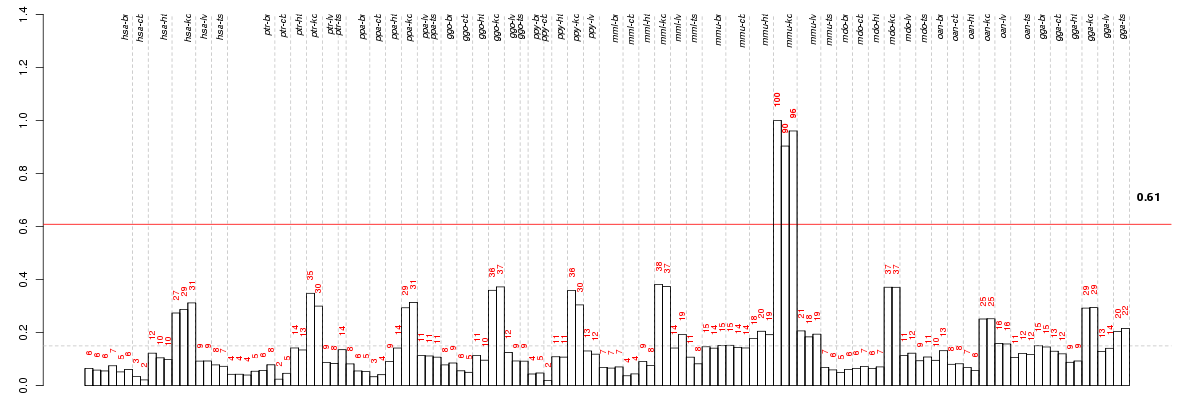



Under-expression is coded with green,
over-expression with red color.


extracellular region
The space external to the outermost structure of a cell. For cells without external protective or external encapsulating structures this refers to space outside of the plasma membrane. This term covers the host cell environment outside an intracellular parasite.
cellular_component
The part of a cell or its extracellular environment in which a gene product is located. A gene product may be located in one or more parts of a cell and its location may be as specific as a particular macromolecular complex, that is, a stable, persistent association of macromolecules that function together.
extracellular space
That part of a multicellular organism outside the cells proper, usually taken to be outside the plasma membranes, and occupied by fluid.
extracellular region part
Any constituent part of the extracellular region, the space external to the outermost structure of a cell. For cells without external protective or external encapsulating structures this refers to space outside of the plasma membrane. This term covers constituent parts of the host cell environment outside an intracellular parasite.
all
NA
extracellular region part
Any constituent part of the extracellular region, the space external to the outermost structure of a cell. For cells without external protective or external encapsulating structures this refers to space outside of the plasma membrane. This term covers constituent parts of the host cell environment outside an intracellular parasite.

molecular_function
Elemental activities, such as catalysis or binding, describing the actions of a gene product at the molecular level. A given gene product may exhibit one or more molecular functions.
catalytic activity
Catalysis of a biochemical reaction at physiological temperatures. In biologically catalyzed reactions, the reactants are known as substrates, and the catalysts are naturally occurring macromolecular substances known as enzymes. Enzymes possess specific binding sites for substrates, and are usually composed wholly or largely of protein, but RNA that has catalytic activity (ribozyme) is often also regarded as enzymatic.
hydrolase activity, hydrolyzing O-glycosyl compounds
Catalysis of the hydrolysis of any O-glycosyl bond.
galactosyltransferase activity
Catalysis of the transfer of a galactosyl group to an acceptor molecule, typically another carbohydrate or a lipid.
beta-glucosidase activity
Catalysis of the hydrolysis of terminal, non-reducing beta-D-glucose residues with release of beta-D-glucose.
glucosidase activity
Catalysis of the hydrolysis of glucosyl compounds, substances containing a group derived from a cyclic form of glucose or a glucose derivative.
transferase activity
Catalysis of the transfer of a group, e.g. a methyl group, glycosyl group, acyl group, phosphorus-containing, or other groups, from one compound (generally regarded as the donor) to another compound (generally regarded as the acceptor). Transferase is the systematic name for any enzyme of EC class 2.
transferase activity, transferring glycosyl groups
Catalysis of the transfer of a glycosyl group from one compound (donor) to another (acceptor).
transferase activity, transferring hexosyl groups
Catalysis of the transfer of a hexosyl group from one compound (donor) to another (acceptor).
hydrolase activity
Catalysis of the hydrolysis of various bonds, e.g. C-O, C-N, C-C, phosphoric anhydride bonds, etc. Hydrolase is the systematic name for any enzyme of EC class 3.
hydrolase activity, acting on glycosyl bonds
Catalysis of the hydrolysis of any glycosyl bond.
all
NA
| Id | Pvalue | ExpCount | Count | Size | Term |
|---|---|---|---|---|---|
| 00601 | 3.738e-02 | 0.05066 | 2 | 7 | Glycosphingolipid biosynthesis - lacto and neolacto series |
A4GNTalpha-1,4-N-acetylglucosaminyltransferase (ENSG00000118017), score: 1 ANKRD13Cankyrin repeat domain 13C (ENSG00000118454), score: 0.48 AOAHacyloxyacyl hydrolase (neutrophil) (ENSG00000136250), score: 0.54 ARSBarylsulfatase B (ENSG00000113273), score: 0.45 ATP11AATPase, class VI, type 11A (ENSG00000068650), score: 0.47 B3GALT5UDP-Gal:betaGlcNAc beta 1,3-galactosyltransferase, polypeptide 5 (ENSG00000183778), score: 0.44 B4GALT2UDP-Gal:betaGlcNAc beta 1,4- galactosyltransferase, polypeptide 2 (ENSG00000117411), score: -0.45 BPNT13'(2'), 5'-bisphosphate nucleotidase 1 (ENSG00000162813), score: 0.58 CDCP1CUB domain containing protein 1 (ENSG00000163814), score: 0.44 COL10A1collagen, type X, alpha 1 (ENSG00000123500), score: 0.54 COL4A4collagen, type IV, alpha 4 (ENSG00000081052), score: 0.45 EGFepidermal growth factor (ENSG00000138798), score: 0.53 EGFL6EGF-like-domain, multiple 6 (ENSG00000198759), score: 0.51 FGFBP1fibroblast growth factor binding protein 1 (ENSG00000137440), score: 0.42 FUCA2fucosidase, alpha-L- 2, plasma (ENSG00000001036), score: 0.44 GAS2growth arrest-specific 2 (ENSG00000148935), score: 0.43 GBA2glucosidase, beta (bile acid) 2 (ENSG00000070610), score: -0.45 GCNT1glucosaminyl (N-acetyl) transferase 1, core 2 (ENSG00000187210), score: 0.68 H1FXH1 histone family, member X (ENSG00000184897), score: -0.51 IL5RAinterleukin 5 receptor, alpha (ENSG00000091181), score: 0.47 KLklotho (ENSG00000133116), score: 0.43 KRT80keratin 80 (ENSG00000167767), score: 0.59 LRRC31leucine rich repeat containing 31 (ENSG00000114248), score: 0.44 MEP1Ameprin A, alpha (PABA peptide hydrolase) (ENSG00000112818), score: 0.96 MEP1Bmeprin A, beta (ENSG00000141434), score: 0.97 MMP13matrix metallopeptidase 13 (collagenase 3) (ENSG00000137745), score: 0.59 NOX4NADPH oxidase 4 (ENSG00000086991), score: 0.45 NUDT19nudix (nucleoside diphosphate linked moiety X)-type motif 19 (ENSG00000213965), score: 0.54 OLFM4olfactomedin 4 (ENSG00000102837), score: 0.5 PLAUplasminogen activator, urokinase (ENSG00000122861), score: 0.45 PPP6R2protein phosphatase 6, regulatory subunit 2 (ENSG00000100239), score: -0.45 RRHretinal pigment epithelium-derived rhodopsin homolog (ENSG00000180245), score: 0.45 SIM2single-minded homolog 2 (Drosophila) (ENSG00000159263), score: 0.42 SLC10A2solute carrier family 10 (sodium/bile acid cotransporter family), member 2 (ENSG00000125255), score: 0.46 SLC13A1solute carrier family 13 (sodium/sulfate symporters), member 1 (ENSG00000081800), score: 0.44 SLC18A1solute carrier family 18 (vesicular monoamine), member 1 (ENSG00000036565), score: 0.74 SOSTDC1sclerostin domain containing 1 (ENSG00000171243), score: 0.44 TMEM27transmembrane protein 27 (ENSG00000147003), score: 0.42 TMIGD1transmembrane and immunoglobulin domain containing 1 (ENSG00000182271), score: 0.55 TNFAIP8tumor necrosis factor, alpha-induced protein 8 (ENSG00000145779), score: 0.55 UPK3Auroplakin 3A (ENSG00000100373), score: 0.53 ZBTB41zinc finger and BTB domain containing 41 (ENSG00000177888), score: 0.44 ZPLD1zona pellucida-like domain containing 1 (ENSG00000170044), score: 0.47
| Id | species | tissue | sex | individual |
|---|---|---|---|---|
| mmu_kd_m2_ca1 | mmu | kd | m | 2 |
| mmu_kd_f_ca1 | mmu | kd | f | _ |
| mmu_kd_m1_ca1 | mmu | kd | m | 1 |
